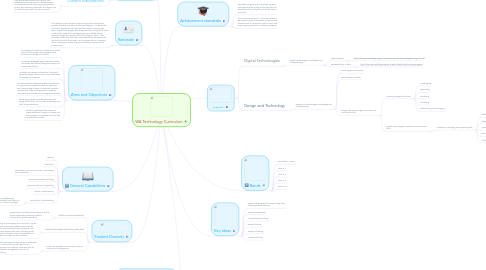
1. General Capabilities
1.1. Literacy
1.2. Numeracy
1.3. Information and Communication Technology (ICT) Capability
1.4. Critical and Creative Thinking
1.5. Personal and Social Capability
1.6. Ethical Understanding
1.7. Intercultural Understanding
1.7.1. Incorporating Australia's neighbouring countries cultures and histories into lessons in being respectful of other cultures heritages.
2. Cross Curriculum Priorities
2.1. Aboriginal and Torres Strait Islander Histories and Cultures
2.2. Asia and Australia’s Engagement with Asia
2.2.1. Through LOTE lessons countries languages such as Japanese and Indonesian languages are taught.
2.3. Sustainability
2.3.1. Sustainability can be incorporated into any subject area of learning through creative processes.
3. Student Diversity
3.1. Gifted and Talented students
3.1.1. Emphasising and elaborating deeper into the content descriptors allowing student independent growth expansion.
3.2. Students with disabilities/learning difficulties
3.2.1. Adjusting and modifying the curriculum may be necessary in providing ability support to the students with additional learning needs. This may meen dipping into prior schooling years curriculum to support areas of weakness and strengthen through inclusive activities.
3.3. ESL/EALD Students and transitioning from multicultural backgrounds.
3.3.1. To assist and support these students additional multi modal resources will need to be implemented to make the transition time for the students manageable and not too confronting.
4. Aims and Objectives
4.1. For students to develop confidence as critical users of technologies and designers and producers of designed solutions
4.2. Students investigate, generate and critique innovative and ethical designed solutions for sustainable futures
4.3. Students use design and systems thinking to generate design ideas and communicate these to a range of audiences
4.4. Students produce designed solutions suitable for a range of technologies contexts by selecting and manipulating a range of materials, systems, components, tools and equipment creatively, competently and safely; and managing processes
4.5. Students gradually evaluate processes and designed solutions and transfer knowledge and skills to new situations
4.6. Students understand the roles and responsibilities of people in design and technologies occupations and how they contribute to society.
5. Rationale
5.1. The rationale is structured to help communicate and educate parents, students and other teaching colleagues. It outlines the curriculum standards and maps out the specific learning area topic. Digital technologies and design and technology both allow students the freedom to independently and collaboratively explore through the depths of the technological world. With provided scaffolding and resources students are equipped with the tools and skills to succeed. Technologies play an important role in restoring, transforming and sustaining society and the environment.
6. Content Descriptors
6.1. Content descriptors build the basis for all learning to occur. They outline and describe the specific skills, knowledge and understanding that is required of the teacher in order to successfully teach the students. Content descriptors do not prescribe a 1 same solution for teaching, It is based on the teacher to create the stepping stones to reach standards.
6.2. Content Elaborations
6.2.1. Content elaborations are provided by the Australian Curriculum for Foundation year to year 10. It encompasses supporting material to help guide what needs to be taught. The elaborations are not meant to be prescribed and followed exactly they are purely guides to ensure your teaching flows with all subjects and all relevant year level content is covered.
7. Bands
7.1. Foundation - Year 2
7.2. Years 3-4
7.3. Years 5-6
7.4. Years 7-8
7.5. Years 9-10
8. Subjects
8.1. Digital Technologies
8.1.1. Digital Technologies Knowledge and Understanding
8.1.1.1. Digital systems
8.1.1.1.1. http://dtm4260.edublogs.org/2016/08/07/move-the-turtle-programming-for-kids/
8.1.1.2. Representation of data
8.1.1.2.1. http://dtm4260.edublogs.org/2016/08/07/kidbot-start-coding-program/
8.2. Design and Technology
8.2.1. Design and Technologies Knowledge and Understanding
8.2.1.1. Technologies and society
8.2.1.2. Technologies contexts
8.2.1.3. Design and Technologies Processes and Production Skills
8.2.1.3.1. Creating designed solutions
8.2.1.3.2. Digital Technologies Processes and Production Skills
